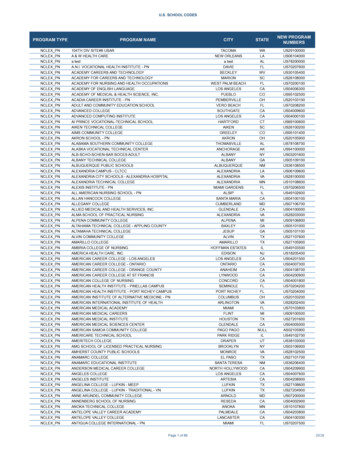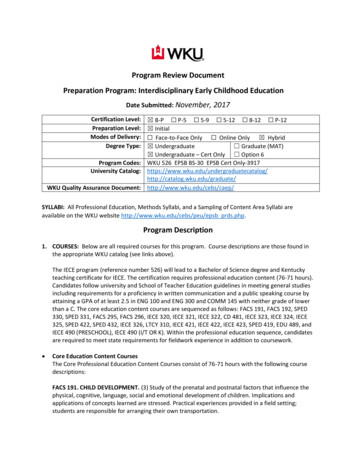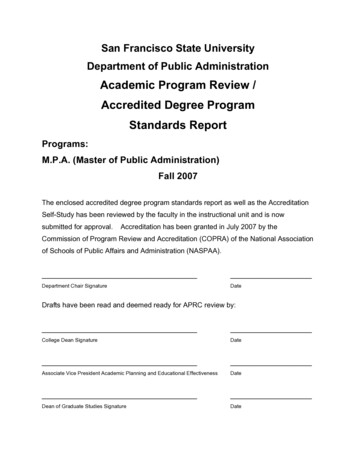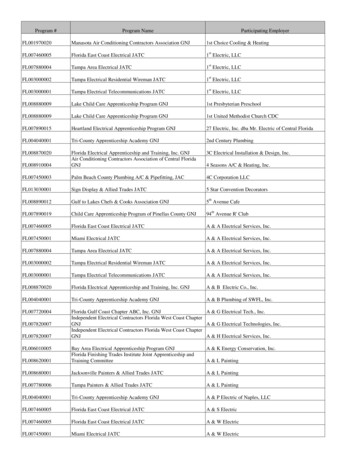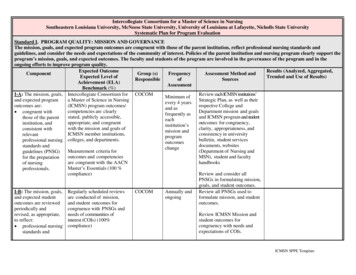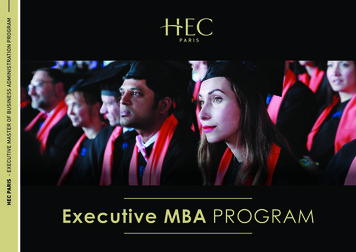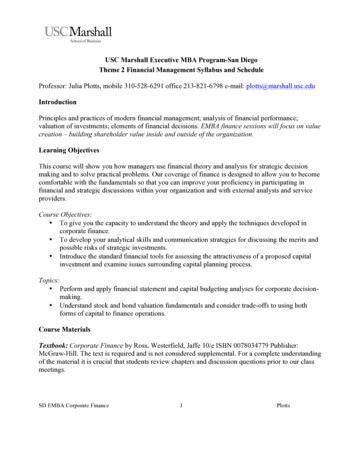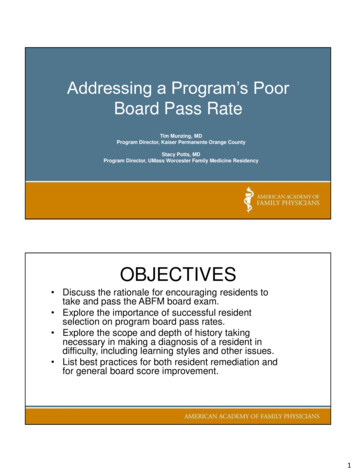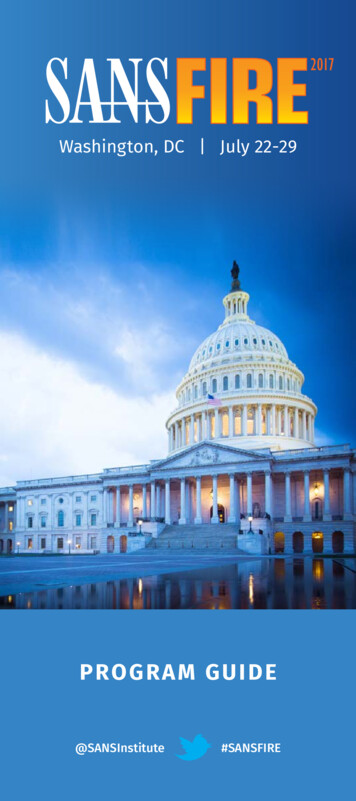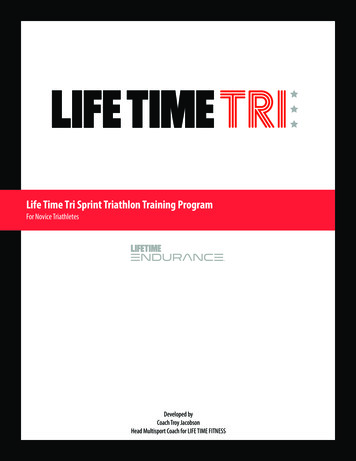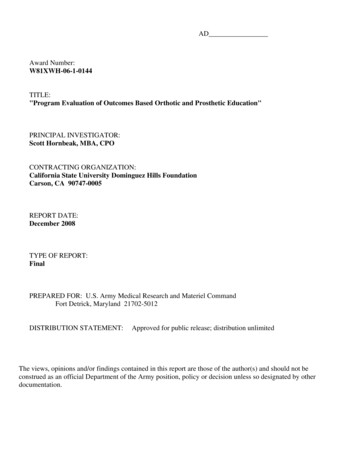
Transcription
ADAward Number:W81XWH-06-1-0144TITLE:"Program Evaluation of Outcomes Based Orthotic and Prosthetic Education"PRINCIPAL INVESTIGATOR:Scott Hornbeak, MBA, CPOCONTRACTING ORGANIZATION:California State University Dominguez Hills FoundationCarson, CA 90747-0005REPORT DATE:December 2008TYPE OF REPORT:FinalPREPARED FOR: U.S. Army Medical Research and Materiel CommandFort Detrick, Maryland 21702-5012DISTRIBUTION STATEMENT:Approved for public release; distribution unlimitedThe views, opinions and/or findings contained in this report are those of the author(s) and should not beconstrued as an official Department of the Army position, policy or decision unless so designated by otherdocumentation.
Form ApprovedOMB No. 0704-0188REPORT DOCUMENTATION PAGEPublic reporting burden for this collection of information is estimated to average 1 hour per response, including the time for reviewing instructions, searching existing data sources, gathering and maintaining thedata needed, and completing and reviewing this collection of information. Send comments regarding this burden estimate or any other aspect of this collection of information, including suggestions for reducingthis burden to Department of Defense, Washington Headquarters Services, Directorate for Information Operations and Reports (0704-0188), 1215 Jefferson Davis Highway, Suite 1204, Arlington, VA 222024302. Respondents should be aware that notwithstanding any other provision of law, no person shall be subject to any penalty for failing to comply with a collection of information if it does not display a currentlyvalid OMB control number. PLEASE DO NOT RETURN YOUR FORM TO THE ABOVE ADDRESS.1. REPORT DATE (DD-MM-YYYY)2. REPORT TYPE3. DATES COVERED (From - To)Final01-12-200815 Nov 2005 – 14 Nov 20084. TITLE AND SUBTITLE5a. CONTRACT NUMBER"Program Evaluation of Outcomes Based Orthotic and Prosthetic Education"5b. GRANT NUMBERW81XWH-06-1-01445c. PROGRAM ELEMENT NUMBER6. AUTHOR(S)5d. PROJECT NUMBERScott Hornbeak, MBA, CPO5e. TASK NUMBER5f. WORK UNIT NUMBER7. PERFORMING ORGANIZATION NAME(S) AND ADDRESS(ES)8. PERFORMING ORGANIZATION REPORTNUMBERCalifornia State University Dominguez Hills FoundationCarson, CA 90747-00059. SPONSORING / MONITORING AGENCY NAME(S) AND ADDRESS(ES)10. SPONSOR/MONITOR’S ACRONYM(S)U.S. Army Medical Research and Material CommandFort Detrick, Maryland 21702-501211. SPONSOR/MONITOR’S REPORTNUMBER(S)12. DISTRIBUTION / AVAILABILITY STATEMENTApproved for public release; distribution unlimited.13. SUPPLEMENTARY NOTES14. ABSTRACT MajorAccomplishments During Project: Expanded O&P program from 28 to 48 graduates per year. RecruitedKate Muller, CPO, as Lead Orthotics Instructor; writing of new Orthotics curricula and syllabi; installation of new OrthoticsLaboratory and teaching of 4 Orthotic and 6 Prosthetic Certificates during the project. Installed “Smart” Classroom, Gait room,and Blackboard (online) Learning System. Development of new Biomechanics, Gait, and Lower Limb Prosthetics curricula.Established student clinical rotation in Navy Medical Center San Diego “C5” Program to work with amputee service membersreturning from Iraq and Afghanistan (OEF- OIF). Outcome Tools Developed During Project: development of comprehensive listof skills and knowledge required of O&P students in cognitive, psychomotor, and afferent learning categories. Creation of 14Program Level Objectives designed to be the centerpiece of an outcomes based Program Evaluation Plan; development ofcheckout criteria for all Orthotic and Prosthetic patient fittings; development of Practical (formative) Exams for each clinicalcourse; transition of all lectures and grading to online Blackboard System; implemented group focus meetings for students toprovide critique of ongoing learning; implementation of Graduate and Employer Questionnaires to provide feedback onteaching content. Development of Patient Surveys to provide feedback on student professional behaviors.15. SUBJECT TERMSProsthetics, Orthotics, Prosthesis, Orthosis, Amputation, Outcomes Based Evaluation16. SECURITY CLASSIFICATION OF:17. LIMITATIONOF ABSTRACTUa. REPORTb. ABSTRACTc. THIS PAGEUUUUU18. NUMBEROF PAGES9019a. NAME OF RESPONSIBLE PERSONUSAMRMC19b. TELEPHONE NUMBERStandard Form 298 (Rev. 8-98)Prescribed by ANSI Std. Z39.18
TABLE OF CONTENTSIntroduction . .4Body .4Key Research Accomplishments . 14Reportable Outcomes .15Conclusions .16References . 17Appendices . .APPENDIX I. GANTT Chart: Accomplishment of Objectives .APPENDIX II. Program Evaluation Plan (.pdf file) APPENDIX III. Photographs of new Labs, Wounded Warriors, Graduates.APPENDIX IV. Article; “Joining Forces” . APPENDIX V. Sample Syllabi – Biomechanics, Directed Research . . APPENDIX VI. Oral Presentation Rubric, Clinical Check-out . APPENDIX VII. Graduate Questionnaire .APPENDIX VIII. Employer Questionnaire . .APPENDIX IX. Patient Survey APPENDIX X. “What We Assess” Matrix (.pdf file) . APPENDIX XI. CAAHEP Accreditation in Prosthetics and Orthotics .APPENDIS XII. List of Personnel and Cumulative costs (12/15/08) .191920212833444851545556583
Program Evaluation of Outcomes Based Orthotic and Prosthetic EducationAward Number: W81XWH-06-1-0144INTRODUCTION:There are not enough qualified Prosthetic and Orthotic practitioners to provide services needed bythousands of military amputees, U.S. Veterans, and other Americans living with disabilities. WithDepartment of Defense funding (2005-2008) the university has significantly increased enrollment inboth its Prosthetic and Orthotic education programs. The goals of building a new laboratory, expandingan existing laboratory, recruiting new faculty, and purchasing specialized equipment wereaccomplished in Year 1. The goal to enlarge training capacity from 28 students to 48 students per year,and was achieved in Year 2. Also during Years 2 and 3 the program focused on moving fromvocational and knowledge based accreditation standards to competence based standards that arefocused on outcomes assessment.During Year 3 a Program Evaluation was conducted, asking the question “What are the effects ofadditional resources and increased training capacity on an Orthotic and Prosthetic training program andits clients? The purpose of the Program Evaluation is to assess the effects of increasing practitionertraining capacity by 71% on program inputs, activities, outputs, and outcomes. This final report willexamine impacts/benefits/changes to students and orthopedic clients as a result of program growth andcurriculum changes during and/or after their participation in this 3 year study. Development of newProgram Level Outcomes has led to linkage between a variety of new and existing outcome assessmenttools, both at the program and course level. Evaluation criteria for each outcome have been developedto provide-data based information to make programmatic decisions, and to provide evidence ofprogram quality and effectiveness.BODY:Program Evaluation of an Outcomes-Based Orthotic and Prosthetic Education ProgramYear 1 Highlights: The investment in remodeling, supplies and equipment in 2006 provided morelaboratory space and an increased capacity to train O&P students. The new capacity is 32 students inProsthetics per year, and a new class capacity of 16 students in Orthotics per year. Total capacityplanned in the project was 48 graduates per year, and this objective was met during Year 1. KateMuller, CPO, was recruited to become the Lead Orthotic Instructor. A new, 1000 square foot teachinglaboratory and 900 square foot “Smart” Classroom were developed in existing space. A remodel of theGait room, two additional offices, and installation of a wheelchair lift and addition of a cafeteriaprivacy curtain were also completed.Year 2 Highlights: Mark Muller CPO, who teaches both Prosthetics and Orthotics, and mostBiomechanics and Gait courses, joined the faculty. The expanded O&P project also recruited a newpart time instructor, Britt-Guerre Aguilar, CPO, who is an ABC certified Prosthetist - Orthotist with 13years of patient care experience. Glenn Ham-Rosebrock, CO, with over 38 years patient careexperience was re-appointed as a part time instructor. Kate Muller, CPO continues in the position ofLead Orthotic Instructor. After obtaining feedback during the first and second Orthotic Certificates(Jan-June, 2006 & 2007), she has revised the Orthotics curricula, including Upper Extremity Orthotics,Spinal Orthotics, Lower Extremity Orthotics, Biomechanics, and Research. During Year 2 the schoolproduced 48 graduates for the first time, achieving the training capacity goal.4
Year 3 highlights: The O&P Program conducted two Orthotic and two Prosthetic Certificate classesin 2008, resulting in a record 62 graduates in one year. Although the Orthotic faculty was overworkedduring this year, the additional enrollment allowed the school to enroll fewer students in SpringSummer 2009, a period when we will move the program 30 miles to a new location at the Long BeachVA Medical Center. During 2008 the CSUDH O&P Program secured a lease agreement with the LongBeach VA Medical Center to move the education program into a new state of the art teaching centerwith over 9000 square feet. The estimated contribution by the VA is 2.2 Million for the build-out,and additional free rental space to CSUDH. With the program’s new capacity, new faculty, newprogram evaluation plan, and new space, CSUDH is becoming the West Coast leader in Prosthetic andOrthotic Education.The Program worked closely with Dr. Mary Cruise, from the Student Learning Outcomes Assessmentgroup (SLOAC) at California State University Dominguez Hills. She is an assessment expert andconsultant to the O&P Program. She has examined all of new and revised assessment tools, such astests, quizzes, surveys, practical exams, research papers, focus groups, rubrics, etc., to analyze how wemeasure various evaluation questions, indicators of their achievement, methods of measurement,results, and areas still in need of improvement.We have worked with Dr. Cruise to identify evaluation criteria utilizing the American Board forCertification “Domains of the Practice Analysis”. The ABC Domains are: Patient Assessment,Formulation of the Treatment Plan, Implementation of the Treatment Plan, Follow-up Treatment Plan,Practice Management, and Promotion of Competency and Enhancement of Professional Practice.In consultation with Dr. Cruise, a Program Evaluation Plan was drafted. (APPENDIX II.) The draftassessment matrix for the report consists of the following elements: Unit of Evaluation,Criteria/Indicators (of evaluation unit), Methods, Results, and Conclusions/Actions.Dr. Cruise and Mr. Hornbeak have formalized the Program Evaluation Plan as part of the finaldeliverable product for this project.The CSUDH O&P Program contacted Mr. Peter Harsch, CP and Commander Kathy Goldberg, RPT atthe Naval Medical Center San Diego (NMCSD) Division of Comprehensive Combat & Casualty Care(C5) Program, in order to offer support of the returning amputee veterans from Iraq and Afghanistan.Our program hosted visits by Mr. Harsch (Balboa Naval Hospital – Chief Prosthetist) with 21 of thewounded veterans to our site in July 2007 and again in 2008. Several of the wounded soldiers have aninterest in pursuing O&P as a career, and received counseling on how to enter this field.Subsequently C5 Commanders at the Naval Medical Center San Diego negotiated with the O&PProgram to secure a formal Affiliation Agreement. With that agreement we started clinical rotations ofprosthetic students into the NMCSD during Fall 2008. Starting in Fall 2008, 16 student and 3 facultymade weekly visits to C5 amputee center (approximately 70 miles from our location). Also see articlein O&P Business News, “Joining Forces”, Nov. 1, 2008. (APPENDIX V.)In Process Review, March 13, 2008:Mr. Troy Turner and Ms. Ashley Glenn visited the CSUDH O&P Program on March 13, 2008 in orderto consult with the faculty who are directing this project. An In Process Review took place to describethe project in detail, and to develop a timeline for the expected deliverables. Mr. Scott Hornbeak andMs. Kate Muller presented the project accomplishments. Dean Mitch Maki, PhD, and Mary Cruise,DNSc., (Assessment consultant) also attended.A detailed summary of the accomplishments associated with each task in Statement of Work follows:5
TABLE 1. ACCOMPLISHMENT OF OBJECTIVES IN STATEMENT OF WORKObjectives/TasksTimeline11/15/05 – 11/14/08Task 1. To increase the training capacity of a universityMonth 1-3641 graduates in O&P in Year 1.Based Orthotics and Prosthetics practitioner trainingCapacity of 48 reached in Year 2.program from 28 students to 48 students per year.62 graduates in Year 3.1.a. Recruit and hire lead Orthotics instructor.Months 1-3Kate Muller, CPO, activelyteaches/leads Orthotics Certificate1.b. rewrite existing orthotics curriculum to meet outcomes Months 1-3Orthotics curriculum updated and taught 4based evaluation standards mandated by National Commissiotimes. Achieved full NCOPE accreditationon Orthotics and Prosthetics Education (NCOPE)through 2009.1.c. Design and install new Orthotics teaching laboratory.Month 1-6Completed Feb. 20061.d. Purchase equipment for Orthotics teaching laboratory.Month 1- 6Completed Feb. 20061.e. Recruit and select first Orthotics certificate class.Months 1-6Completed Jan. 20061.f. Purchase expendable supplies for orthotics andprosthetics expansion.1.g. Add 4 prosthetic students per year.1.h. Teach 32 prosthetic certificate students per year;and 16 orthotic certificate students per year.Task 2. To perform program evaluation on the effects ofincreasing program capacity from 28 graduates to 48graduates per year.2.a. Assess changes in program inputs; faculty, staff,facilities, equipment, expendable supplies, and budget.Months 1-362.b Assess changes in activities and processes; teachingmethods, patient models, curriculum changes, studentteacher ratios, advising, and placement. (Months 7-36)2.c. Assess changes in program outputs; number of peopletaught, number of graduates, and estimates of orthopedicclients affected.100% of expendablesupplies have been purchased.Months 1- 36 12 students added by 2008Months 13-36 Program met capacity of 32 ProstheticAnd 16 Orthotic students in Jan. 2007Months 1-36 Program has expanded from 28graduates to 48 graduates. ProgramEvaluation Plan is in place.Months 1-36 Kate Muller, CPO, and Mark Muller, CPO,hired. 2 part time faculty hired (HamRosebrock and Guerre-Aguilar). Hornbeakand Ramirez contribute 20% time each toOrthotics Program. 128,669 for majorequipment, 47,000 supplies, 22,770consultants has been expended.Months 7-36 Practice Management, Anatomy, MaterialsScience, Gait, Biomechanics and Researchhave doubled in capacity. Student-teacherratio increased to 32:1. Orthotic patientmodels now utilized in all Ox courses. Allsyllabi and lectures available via BlackboardLearning System. Student-teacher ratios haveincreased to 16:2.5 in all (P) and (O) labcourses. Placement into Residency is 99%.Months 13-36 Expanded from 28 graduates in 2005to 48 graduates in 2007. (71% increase).Clients affected: At 8.5 clients seen per day,each new graduate will see 2125 clients peryear. Managers will effectively see (3X) or6375 per year. Practitioner/Mgr. ratio 3:1.Therefore class of 48 treats (at 36:12 ratio) 153,000 clients seen per year.6
Objectives/Tasks2.d. Assess student outcomes:1. Knowledge (congnitive) and Skills (psychomotor)2. Behavior (afferent).3. Values2.e Assess outcome targets and indicators; percent whograduate, percent who achieve “B” or above in cognitiveand psychomotor domains; percent who achieve 80% orabove in professional behavior, percent who achieve 80%or above on demonstrated core values, percent placed inResidency, and percent who pass ABC certification.Task 3. To write, review, and present Program Evaluationto stakeholders. (Months 24-36)TimelineMonths 7-36Months 13-36Months 23-3611/15/05 – 11/14/08Existing cognitive and psychomotor examsand rubrics in place; new Practical exams ineach clinical course written. New OralPresentation Rubric, Graduate QuestionnaireEmployer Questionnaire, and Patient Surveyhave been written to assess these outcomes.Psychosocial, professional, and ethicalbehaviors have been incorporated.Months 24-36 99% of accepted students in O or PCertificates graduated. All scored at“B” or better in cognitive and psychomotordomains. Students scoring above 80% onProfessional behavior as measured inCritiques and Patient Surveys. 100% ofgraduates placed in Residency or returning toschool for other discipline.71% have passed ABC Certification incombined Winter ‘06 and June ‘07 exams.Months 24-36 Final report including Program Evaluationcompleted and submitted to TATRC.The Statement of Work (Summary in TABLE I) breaks down this project into two major tasks: Task 1,Increasing training capacity and Task 2, Performing Program Evaluation. The following highlightsspecific progress relative to the project objectives associated with these tasks:Task 1: To increase training capacity of an Orthotics and Prosthetics education program from 28graduates to 48 graduates per year. Specific project objectives and their status at the close of theproject are denoted in Bold.1. To increase the training capacity of a university based Orthotics and Prosthetics practitionertraining program from 28 students to 48 students per year. Done; end of Year 1.2. To increase the number of qualified practitioners available to serve the nation's disabledpopulation, with specific focus on service to military amputees and orthopedically disabled.Done, all 3 years of project. (151 graduates)3. To rewrite, develop, and implement a new Orthotics curriculum. Done; end of Year 1.4. To increase the capacity of the existing Prosthetics training program. Done; Year 1.5. To conduct an outcomes-based Program Evaluation of the effects of program growth from28 students to 48 students per year. Started in Year 1; continues thru Year 3.Task 2: To perform program evaluation on the effects of increasing program capacity from 28graduates to 48 graduates per year. Specific project objectives and their status at the close of theproject are denoted in Bold.7
6. To assess changes in program inputs; faculty, staff, facilities, equipment, expendablesupplies, and budget. Done; 2 new full time and 2 new part time faculty hired. NewOrthotics Lab completed, Prosthetic Lab expanded, New equipment purchased, suppliesand consumables purchased.7. To assess changes in activities and processes; teaching methods, patient models, curriculumchanges, student-teacher ratios, advising, and placement. Done; ongoing. Development of 14new Program Level Outcomes led to linkage between new and existing outcomeassessment tools. Student to teacher ratio in didactic classes is now 32:1. Student toteacher ratio in laboratory is now 16:2.5. All syllabi, announcements, grading, PowerPoint lectures, and videos are now online. Distance learning modules from AAOP(Academy Learning Center) are now online. Course objectives are currently beingrevised to insure student achievement of 14 new program-level outcomes.8. To assess changes in program outputs; number of people taught, number of graduates, andestimates of orthopedic clients affected. Done; ongoing. Expanded from 28 graduates in 2005to 48 graduates in 2007, a 71% increase. (151 total graduates during 3 year project). Clientsaffected: At 8.5 clients seen per day, each new graduate will see 2125 clients per year.Managers will effectively see (3X) or 6375 per year. Practitioner/Mgr. ratio 3:1. Thereforeclass of 48 treats (at 36:12 ratio) 153,000 clients seen per year.9
Scott Hornbeak, MBA, CPO 5d. PROJECT NUMBER 5e. TASK NUMBER 5f. WORK UNIT NUMBER 7. PERFORMING ORGANIZATION NAME(S) AND ADDRESS(ES) California State University Dominguez Hills Foundation 8. PERFORMING ORGANIZATION REPORT NUMBER Carson, CA 90747-0005 9. SPONSORIN
